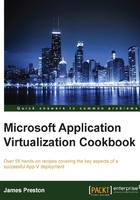
Introduction
Microsoft Application Virtualization 5 (App-V 5) enables system administrators to deliver applications to end users in a consistent and efficient manner without the hassle of traditional deployment methods.
The individual components of App-V 5 can be used in a variety of combinations to meet your particular needs. A full App-V 5 server deployment would employ the following services:

The flexible nature of App-V also allows for applications to be deployed through Microsoft System Centre Configuration Manager (SCCM) as well as through Electronic Software Distribution, for example, with Group Policy assignments. In this cookbook, we will cover these alternative deployment methods in later chapters.
We will use the following IP addresses and hostnames in order to cover the full range of deployment options. Each server runs Windows Server 2012 R2 on the 255.255.248.0 subnet. These servers can be configured as virtual or physical machines. I suggest that you use vCPU, RAM, and storage allocations for the demo environment, which can also be found in the following table:

The 172.16.0.12 and 172.16.0.13 IP Addresses should be reserved for use with Network Load Balancing (NLB).
In addition, you will need to create a number of Windows 8.1 clients for the sequencing and testing of applications as well as to access the App-V management console.
Tip
Note that the specifications in the preceding table are only suitable for a demo environment. For your production environment, consult the App-V 5.0 Capacity Planning page at https://technet.microsoft.com/en-gb/library/dn595131.aspx.